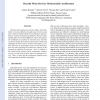Free Online Productivity Tools
i2Speak
i2Symbol
i2OCR
iTex2Img
iWeb2Print
iWeb2Shot
i2Type
iPdf2Split
iPdf2Merge
i2Bopomofo
i2Arabic
i2Style
i2Image
i2PDF
iLatex2Rtf
Sci2ools
APSCC
2009
IEEE
2009
IEEE
Security meta-services orchestration architecture
SOA have been deployed as a mean to offer a better flexibility, to increase efficiency through reuse of services and also to improve interoperability by providing new opportunities to connect heterogeneous platforms. However, those benefits make security more difficult to control. Fortunately, new standards are proposed to treat this issue, but their current use makes the architecture much more complex and challenges the characteristics of SOA. In this paper, we address this issue by separating security services from business ones and organizing the architecture referring to the principle of separation of concerns. Next, we propose a new model which consists of three components: business services, security meta-services and an orchestration service. Then, we show that the architecture remains secure while enforcing its flexibility and agility.
| Added | 18 May 2010 |
| Updated | 18 May 2010 |
| Type | Conference |
| Year | 2009 |
| Where | APSCC |
| Authors | Aymen Baouab, Olivier Perrin, Nicolas Biri, Claude Godart |
Comments (0)

